
Stephen Morris tells the story of the Dominator, the bus chassis that put Dennis back on the map and provided an important foundation for what is now Alexander Dennis Ltd [wlm_nonmember][…]
By subscribing you will benefit from:
- Operator & Supplier Profiles
- Face-to-Face Interviews
- Lastest News
- Test Drives and Reviews
- Legal Updates
- Route Focus
- Industry Insider Opinions
- Passenger Perspective
- Vehicle Launches
- and much more!
But scroll back 40 years and bus building in Britain was a very different business. Twenty-three years before the two companies were to merge, Alexander was thriving as a body builder, but Dennis was just dipping its toe back into a market it had left 10 years previously. Despite a history dating back to the 19th century, and having built its first double-decker in 1906, by the late 1960s Dennis had departed the bus industry after building its last five Loline III double-deckers in early-1967.
The 1970s was a difficult time for the bus industry. There was an urgent need to replace fleets with buses suitable for one-person operation, a process encouraged by generous Government grants and a desperate need to cut costs in the light of huge passenger losses. Leyland, which had hoovered up all double-deck bus builders in Britain, was rationalising its range, had difficulties in meeting the demand, problems with spare parts supply and a ‘take it or leave it’ attitude. Operators wanted alternative suppliers. In particular, they wanted the fuel economy and reliability of the Gardner engine, which Leyland was about to delete from its popular Fleetline model. The door was wide open for rival manufacturers to come: and come in they did.
MCW, concerned for the future of its bodybuilding business, teamed up with Scania, truck dealer Ailsa Trucks developed a front-engined bus chassis with Volvo components and some of the Passenger Transport Executives worked with Foden on a new Gardner-engined double-decker. The Foden looked promising, but needed more development work – and Foden had gambled on a big new factory for a truck market which then collapsed. It couldn’t commit the resource to continue development.
Leyland’s pursuit of a standardised offering also spelt the end of the Victory, a front-engined model popular for both double-deck and single-deck applications in certain Commonwealth markets, where simplicity, high ground clearance and rugged reliability were more important than the easier access and sophistication of rear-engined models.
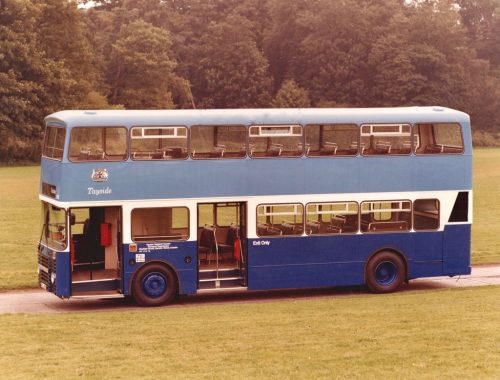
Hilditch influence
In 1972 Dennis had been bought by the Hestair Group, formerly the Heston Aircraft Company, based at Heston Aerodrome near Hounslow. Under its new parentage Dennis was contemplating a comeback, encouraged by some operators both in the UK and in export territories. The Engineering Director of West Yorkshire PTE, one Geoffrey Hilditch (it was he who as General Manager at Halifax had ordered those last five Lolines) lent Dennis a front-engined former Leeds Daimler CVG6 to use as a development testbed.
Hestair was an equipment supplier to the aviation industry, firstly modifying Spitfires and producing components for de Havilland, and later building aircraft steps, forklift trucks and airport tugs. Its work on airport tugs had involved working with German transmission manufacturer Voith, then little known in the British bus industry. Thus a Gardner 6LXB engine and Voith torque-converter transmission were fitted into the Daimler CVG6, which was painted red and put into service in London amongst other places. The combination worked well.
West Yorkshire PTE was interested in a new-generation bus to replace the Daimler Fleetline, as was Hilditch’s counterpart at South Yorkshire, Norman Kay. As well as developing its new Fleetline-style chassis, which was named the Dominator, Dennis developed a front-engined export double-decker, the Jubilant, aimed at the Leyland Victory market. It began to enter service in early 1978.
Just one went to South Africa, for City Tramways in Cape Town, but 375 were built for Hong Kong.
Meanwhile Geoffrey Hilditch had left West Yorkshire and taken over as General Manager at Leicester City Transport, which became the first operator to take delivery of a Dominator, officially handed over on 28 October 1977. It was conventional in design, with a bolted steel chassis frame and a drop-centre rear axle to allow low-height bodywork to be fitted. The Gardner 6LXB 180bhp engine was fitted transversely across the rear driving through a Voith Diwa D851 three-speed automatic gearbox. Voith quickly established itself; the gearbox was reliable, not open to driver abuse and its built-in retarder saved costs on renewing brake linings. MCW was also to adopt the Voith box when it severed its ties with Scania and built its own Metrobus.
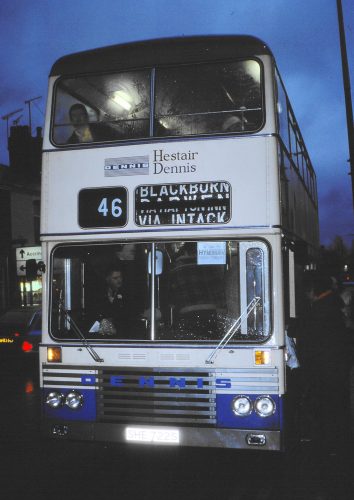
One of the issues with first-generation rear-engined buses was the build-up of heat in the engine bay, so the Dominator’s radiator was at the front, designed in such a way as to minimise intrusion onto the platform. The bus had leaf suspension with telescopic shock absorbers at the front and piston-type at the rear; compared with other leaf-sprung buses it had an extremely good ride, though Dennis made it known that other suspension methods were being considered.
Although one of the Dominator’s raisons d’être was to give operators the choice of a Gardner engine, it was also designed to be available with a Rolls Royce Eagle 220. South Yorkshire PTE (SYPTE), with its hilly territory, was particularly keen on the Rolls Royce engine, and also favoured Voith transmissions: indeed it had even specified Leyland Atlanteans with Voith transmissions, an option not usually open to UK customers.
It was probably appropriate, given Geoffrey Hilditch’s encouragement of the Dominator, that the first should go to Leicester. It entered service in February 1978, though in fact the first production bus was a Rolls-Royce-engined vehicle for South Yorkshire. It was used as a demonstrator by Dennis for about a year before SYPTE put it into service on the notoriously gruelling Sheffield cross-city service 51 (Herdings-Lodge Moor) in comparative trials with a Leyland Titan, a Foden, an Ailsa and an MCW Metrobus together with an Atlantean with a Voith gearbox.
As had been the case with the Fleetline, the Dominator was available in lengths up to 36ft (11m) so it could be bodied as a single-decker. The Dominator appeared at the 1978 Motor Show, the first in the new Birmingham National Exhibition Centre and the first which combined the Motor Show and Commercial Motor Show. The Dennis stand featured not only a Leicester Dominator, but a long-wheelbase double-decker for China Motor Bus in Hong Kong, and the first single-decker, a 36-footer with a controversial new Marshall Camair 80 body for Darlington.
The Dominator quickly established a niche for itself, primarily as a municipal bus, though National Bus Company used the seventh production chassis in comparative trials with a Foden and a Bristol VRT at PMT. With an Alexander low-height body it was the first bodied by a builder other than East Lancs. Six more were built for National Bus Company, unusually with Willowbrook bodies, and they were delivered in early-1980 to Maidstone & District for comparative trials with MCW Metrobuses and Bristol VRTs, firstly in Hastings and then in the Medway Towns, which could almost rival Sheffield for hilly urban routes. Leicester however was the most prolific customer and took 26 of the first 36 to be built, mostly with East Lancs bodies though two delivered in 1978 had the first double-deck bodies built by Marshall, never known as a double-deck builder.

Other operators taking early double-deckers included municipal operators East Staffordshire, Hyndburn, Blackburn and Derby (Derby also took Marshall bodies), Greater Manchester and Merseyside PTEs and independents OK Motor Services, A1 and AA in Scotland. Scottish Bus Group company Central SMT bought one to try, with Alexander bodywork, and went on to buy another 50, while Western SMT also took 12. Single-deckers went to Darlington, which took 18, Barrow, Hartlepool, Merthyr Tydfil and Thamesdown. Only 37 single-deckers were built, including one used as an Incident Command Unit by Tyne & Wear Metropolitan Fire Brigade. Most were bodied by Marshall, though those for Barrow, which took just two, and Hartlepool were bodied by East Lancs.
A big breakthrough came at the end of 1979 when SYPTE ordered 144 Dominators. SYPTE effectively wanted its own bespoke bus and Dennis had always been good at making bespoke products. The first Dominator had clearly impressed, and what South Yorkshire wanted was a version with the Rolls-Royce engine, the first volume order for that engine from a UK bus operator, and Voith transmission. It didn’t need the low-height capability of the drop-centre rear axle so a straight Kirkstall hub-reduction axle was specified instead, along with air suspension. Bodywork would be Alexander’s recently announced R-type, again to SYPTE’s specification. Delivery began in the spring of 1981, by which time around 170 Dominators had been built, 67 of them for Leicester, though new customers had included Eastbourne and Chester. Altogether South Yorkshire was to take 322 Dominators, and one was even converted into an experimental trolleybus which ran on a test line alongside Doncaster racecourse.
Family of vehicles

There were export sales too. Following the 1978 show exhibit, China Motor Bus took a further six, though the other major operator in Hong Kong, Kowloon Motor Bus, bought 40 with locally-assembled Duple Metsec bodies in 1984. Duple had now joined Dennis in the Hestair Group. Singapore Bus Services also took one.
Although these were the only export sales of the Dominator as such, the bus operators in Hong Kong were looking for bigger buses with a seating capacity of 100-plus. Dennis responded in 1982 with a 12m three-axle variant of the Dominator called the Dragon, which sold in vast numbers to the Hong Kong operators, mainly with Duple Metsec bodies. Although identical, those sold to China Motor Bus were named Condors to create a distinction from rival operator Kowloon Motor Bus. Altogether 1,650 Dragon/Condors of different lengths were built, including 30 for Stagecoach’s African operations, 10 for Malawi in 1992 and a further 20 for Kenya in 1995/96. The Kenyan buses were later repatriated to the UK and used on Stagecoach’s Magic Bus operations in Manchester.
The Dragon wasn’t the only spin-off from the Dominator. Geoffrey Hilditch also wanted a Gardner-engined single-decker and in place of the rather clumsy Dominator single-decker, commissioned a version with an underfloor engine at the rear. It still used the Gardner/Voith driveline but using a horizontal version of the engine and with the gearbox mounted ahead of the rear axle to improve weight distribution, shorten the rear overhang and give a decent length of propshaft. The resulting layout resembled Bristol’s RE, the most successful of the first-generation single-deckers. A Duple Dominant bus body was fitted and created a very competent single-decker; ‘Leicester’s answer to the Leyland National’ as Geoffrey put it.
Development didn’t stop there. The Falcon HC had the gearbox close-coupled to the engine and a double-deck version, the Falcon V, with an in-line Mercedes-Benz V6 engine under the floor followed. The prototype was never bought by an operator and finished up as a playbus in Stevenage, though Nottingham bought two and Greater Manchester Transport had three. Allowing seats to the rear of the lower deck increased the seating capacity over the Dominator, it gave a simpler driveline and it saved about half a ton. Though it never succeeded in its own right, it set Dennis on a course of in-line engine designs which it called T-Drive, of which the Dart would be far and away the most successful.

At the same time coach services had been deregulated and competition between operators was pushing up the quality. Leyland had only mid-engined chassis to offer, but National Express wanted something British-built to compete with other operators able to buy exotic rear-engined imports. The gauntlet was thrown down; manufacturers had six months to come up with something. Duple had its smart, high-floor Goldliner body in production and Dennis produced a new 12m long version of the Falcon. The Dominator-derived frame was low enough to allow luggage space between the axles. Dennis was already experienced with the fast-revving and powerful Perkins V8-640 engine in its fire engines, and this was coupled to the Voith gearbox. The resulting coach was extremely fast and quiet and with air suspension and the low Dominator frame keeping the centre of gravity low, it rode very well. The Duple body was impressively finished and in almost every respect it met National Express’s specification perfectly: except for reliability. As a double-deck bus chassis modified for long-distance, high-speed motorway use with the engine from a fire engine, a gearbox designed for city buses and developed from the drawing board in six months flat, it didn’t cover itself with glory. Just 10 were built, but when they did work they were cracking!
An alternative transmission was offered in the Dominator in 1981, from a new British manufacturer, Maxwell. It used four gear trains in constant mesh
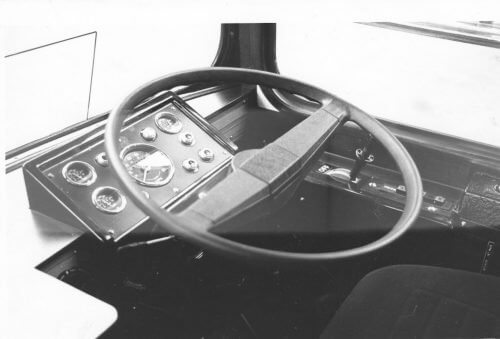
which were selected by using electromagnetic clutches. It incorporated its own angle drive and clutches could also be engaged to give retardation. It saved 319lb in weight over the Voith and clutch packs could be changed in minutes through detachable covers on the end of the gearbox; when conventional automatics needed bands, replacing it involved removing the gearbox altogether.
Despite its advantages the Maxwell was not taken up in large numbers, although it was standard equipment in a further Dominator spin-off, the Domino midibus. This was built primarily to replace the rather unsatisfactory Seddons used on Greater Manchester’s Centreline service, linking Manchester’s two main railway stations. Twenty were built with a stylish Northern Counties body and Perkins T6.354 130bhp engine. South Yorkshire also took 14 with the first new body developed by a fledgling manufacturer called Optare, using as many parts as possible in common with its Dominators. It presaged the Dart, but was slightly ahead of its time and, being derived from a double-decker, massively over-engineered.
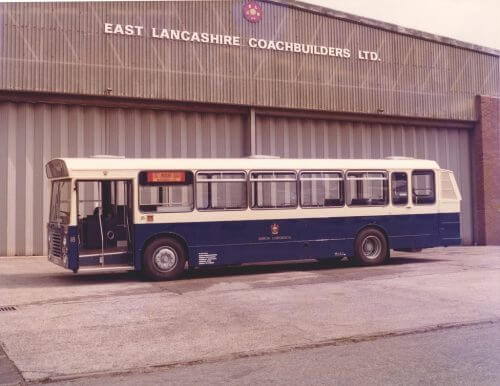
19 year production run
The 1981-86 period was the Dominator’s finest hour. Some 700 Dominators were built; Greater Manchester took another 30 in 1985, Cleveland Transit, having tried two early ones bought 21 over the 1981-86 period and new customers included Kingston-upon-Hull City Transport, which bought 10 in 1984 but was to build up a fleet of 51, Clydeside Scottish with 12 in 1985, Warrington and Southampton. London Transport also tried three in 1984.
But as bus deregulation came into place South Yorkshire’s big orders came to a halt, as did everyone else’s. Dennis had a huge, and very old factory in Guildford, and bus production took up a tiny corner of it. It seemed that Dennis would soon be one of the long line of British manufacturers that had disappeared into oblivion. Over the next two years only 38 Dominators were built, 13 for the ever-faithful Leicester and 25 for Hull. Fortunately for Dennis, Kowloon Motor Bus was able to bring forward some orders and took 225 Dragons over that period, which saved the day.
However the Dominator was not quite finished. A new engine option was offered from 1988. American manufacturer Cummins was building a 10-litre turbocharged engine in Scotland. Its lowest power rating, 180bhp, matched the Gardner 6LXB and it proved to be as fuel-efficient. The L10 was quickly accepted by UK bus operators and Dennis offered it in the Dominator from 1988.
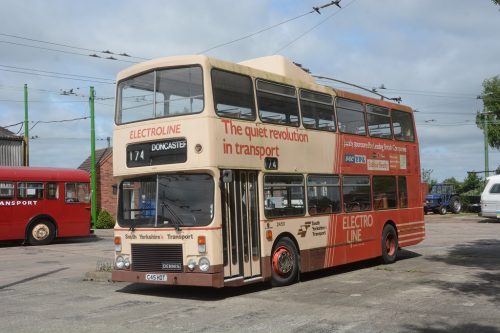
Leicester was the first with a batch of 13 delivered that year. Geoffrey Hilditch had retired from Leicester in 1984, and after deregulation and privatisation joined one of the emerging bus groups, Drawlane, later renamed British Bus and ultimately a component of Arriva. Drawlane also bought East Lancs Coachbuilders and took 33 Dominators for its London & Country, North Western and Midland Red North companies.
In 1990 the Woodbridge Works site in Guildford was sold for redevelopment as a high-tech science park, and Dennis was able to regroup on its new site, a purpose built — and much smaller – factory on the site of an old refuse tip at Slyfield on the edge of Guildford. Dominator production continued at the new factory, and it attracted new customers in the shape of Frontrunner South East for London contract work, Bournemouth Transport, which belatedly standardised on the Dominator and took 18 in 1990-92, and Maynes of Manchester, which bought three in 1993, 15 years after production had begun.

That certainly looked like the end of the line. The Slyfield factory had a new product range to get on with. New ‘T-drive’ chassis using Cummins’ smaller C-series engines had been developed, the Lance, which spawned the first new generation low-floor buses, and the Arrow double-decker. Meanwhile the demise of Bedford had left a gap for middle-weight coaches, which Dennis filled admirably with the Javelin.
The C-series engine was fitted within the wheelbase, but close to the rear axle, giving scope for a spaceframe luggage bay, thereby combining the advantages of a mid-engined chassis with those of a rear-engined chassis. And in response to hundreds of minibuses going into service on deregulated bus routes, Dennis’s Dart gave operators a ‘proper’ bus with the attributes of a minibus. The Dart was to be Dennis’s most successful product ever; more than 12,000 were built before it evolved into the Enviro200.
Yet after a gap in production of three years, four more Dominators were built for British Bus subsidiary Guildford & West Surrey as late as 1996. In 19 years 1,007 Dominators had been built. Hardly record-breaking, and the Dominator, a good old-fashioned workhorse, was a solid plodder, never destined to set the world on fire. But it brought Dennis back into the market. It looked like the end would have come in 1986, had KMB not waded in with those Dragon orders. Yet by 1990 Dennis had transformed itself and was taking the bus world by storm with a range of innovative products which were just what the market needed. The Dominator had re-established Dennis in the bus world and given it a very solid platform on which a huge success was to be built.
[/wlm_ismember]


